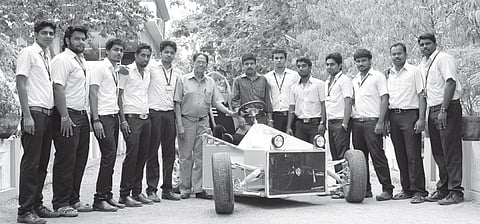

W hen the fuel prices are skyrocketing and one needs their vehicle’s engine to be efficient which utilises bare minimum space of an automobile, a group of 11 automobile engineering students from Matha College of Technology, North Paravur have developed a new technology known as Integrated Starter Generator or ISG technology. As the name suggests it integrates the functions of a starter, generator as well as a motor into a single unit, eliminating the use of three motor units in a vehicle. The students have developed this as their final year project in an off road buggy. “When we thought about developing something, the first thing that came to our minds was a supplementary motor which supplies drive to the engine during the peak load conditions and also which reduces the fuel consumption of the engine,” says Harikrishnan L, team leader of the project.
About ISG Technology
“In ISG technology, the functions of starter motor, generator/alternator and motor are integrated onto a single unit or a DC machine. The DC machine which rotates as a motor when connected across a battery also produces DC current during rotation when supplied with a mechanical drive from the engine. The ISG unit gives a DC voltage of about 34.6v and the current produced by the unit is utilized for charging the battery of the vehicle,” explains Harikrishnan.
Working
The students have used Bajaj Pulsar 220 DTS-i engine to develop their technology. “We have used a two-wheeler engine for ISG. By means of a V-belt drive ISG unit is connected to the engine. Then the output from the engine or the input to the engine from the ISG unit is taken near the balancer of the engine. An electromagnetic clutch controls the drive from the engine and to the engine. While engaging the clutch at the time of starting, the drive can be transmitted from the ISG unit to the engine and to the ISG unit from the engine during current generation for battery charging,” says Sreekumar T S, team member. The electro-magnetic clutch is operated by a switch by the driver.
“At the time of starting the engine, current from the battery is supplied to the ISG unit and as the motor starts running, the electro-magnetic clutch is engaged and the drive from the engine is transmitted to the engine which will start it. After starting the engine, the battery supply to the motor is disconnected and allows the ISG unit to rotate with the same engine speed which starts charging the battery of the vehicle. A voltage of about 34.6dc V is obtained across the ISG unit. Since direct current is obtained across the ISG unit, it does not need any rectification or other complex charging circuits for current conversion from AC to DC as that in alternator (used in cars and buses) or magneto (used in two wheelers),” explains Harikrishnan.
Other highlights
During the travel through the hilly areas ISG unit supplies drive to the engine as a motor assist to the engine through the input shaft fixed to the engine through the belt drive from the ISG unit, which helps in reducing the extra fuel consumed during the extreme conditions under gone by the vehicle. Other than that, ISG helps in improving the fuel efficiency of the vehicle in normal roads also. It helps in damping unnecessary vibrations produced during the normal working of the engine,” says Harikrishnan.
As the ISG unit is setup outside the engine, the maintenance of the unit is also easy.
“The frame and body of the project vehicle is constructed in such a novel manner that the front and rear wheel track are entirely different that is front wheel track is greater than rear one. The centre of gravity of the vehicle is almost at the centre/middle of the vehicle so that the stability of the vehicle is excellent in all driving conditions,” claim the students.
Difference with other existing technologies
“The vehicles that are existing today uses three different units such as a starter- motor, alternator/generator and motor for performing functions such as starting the engine, current generation for charging the battery and locomotion of vehicle respectively. These units are installed individually on different portions of the engine. All these units have different wiring circuit which makes the whole wiring diagram more complex,” says Harikrishnan.
“As mentioned earlier the starter motor starts the engine after starting the engine it remains in a state of rest i.e. it is a passive device. The alternator or magneto (used in two wheelers for current generation) used in the vehicles, produces fluctuating current, hence it has to be made DC (direct current) for charging the battery. An additional circuit must be installed for this above mentioned conversion of current, which makes the wiring circuit of the vehicle more complex but in our technology a steady DC current is produced. And taking the case in hybrid vehicles, a motor drive is present above all these, which again requires additional space and makes the overall wiring circuit more and more complex,” he adds. “Other than that the internal combustion engines (IC engines) used nowadays requires more amount of fuel than the usual required amount during hill climbing or uneven roads. Thereby increasing the overall fuel consumption of the engine and reduces the fuel efficiency and fuel economy of the vehicle,” he says.
The overall cost for the project is Rs 1, 45000 including the cost for constructing the frame and other accessories of the project.
Project crew consists of Akash S, Appu Chandran, Dawn Thomas, Jaison George, Jixon George, Joseph Varghese, Lijo Varghese, Vishnu Mohan and Sujin S Ambady. The project was completed under the guidance of prof E K Mathai, assistant prof Krishnakumar Vijayarajan and external guide Renjith Baburaj.